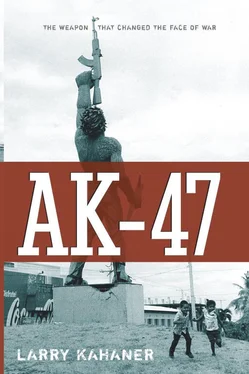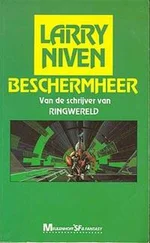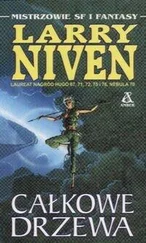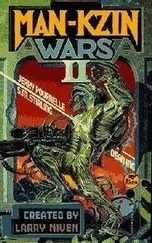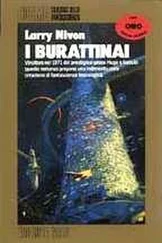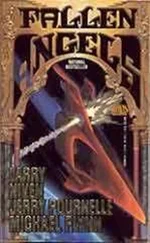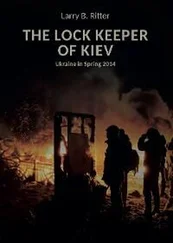Larry Kahaner - AK-47
Здесь есть возможность читать онлайн «Larry Kahaner - AK-47» весь текст электронной книги совершенно бесплатно (целиком полную версию без сокращений). В некоторых случаях можно слушать аудио, скачать через торрент в формате fb2 и присутствует краткое содержание. Город: Hoboken, Год выпуска: 2007, ISBN: 2007, Издательство: John Wiley & Sons, Inc., Жанр: История, military_history, на английском языке. Описание произведения, (предисловие) а так же отзывы посетителей доступны на портале библиотеки ЛибКат.
- Название:AK-47
- Автор:
- Издательство:John Wiley & Sons, Inc.
- Жанр:
- Год:2007
- Город:Hoboken
- ISBN:9780470315668
- Рейтинг книги:3 / 5. Голосов: 1
-
Избранное:Добавить в избранное
- Отзывы:
-
Ваша оценка:
- 60
- 1
- 2
- 3
- 4
- 5
AK-47: краткое содержание, описание и аннотация
Предлагаем к чтению аннотацию, описание, краткое содержание или предисловие (зависит от того, что написал сам автор книги «AK-47»). Если вы не нашли необходимую информацию о книге — напишите в комментариях, мы постараемся отыскать её.
AK-47 — читать онлайн бесплатно полную книгу (весь текст) целиком
Ниже представлен текст книги, разбитый по страницам. Система сохранения места последней прочитанной страницы, позволяет с удобством читать онлайн бесплатно книгу «AK-47», без необходимости каждый раз заново искать на чём Вы остановились. Поставьте закладку, и сможете в любой момент перейти на страницу, на которой закончили чтение.
Интервал:
Закладка:
A deal brokered by the United Nations allowed the Soviet Union to withdraw from Afghanistan and save face. The agreement specified that the Russians had entered Afghanistan to aid a friendly government, the DRA, but now threats to its well-being were diminished and a Soviet force was no longer necessary. Calling it “Afghanization”—Afghans deciding the best course for Afghanistan—Gorbachev insisted that the agreement call for Pakistan not to interfere in Afghan affairs and to sever aid to anti-Soviet groups.
Economically, the war’s drain on the faltering Soviet financial system had been enormous, perhaps $2.7 billion annually from 1980 on. Moreover, approximately twenty-two thousand Soviets were killed and seventy-five thousand wounded. The Soviet invasion decimated Afghanistan. About ninety thousand Afghan combatants died, with an equal number wounded. More than 1.3 million Afghan citizens perished. One-third to one-half of the country’s net worth was damaged or destroyed. Agricultural production dropped by 50 percent and livestock losses were 50 percent, mainly due to Soviet bombings and towns leveled with no people left to care for the animals or tend the land. As many as five thousand of the nation’s fifteen thousand villages were destroyed or made unlivable. United Nations estimates suggest that 70 percent of paved roads were destroyed.
ON FEBRUARY 15, 1989, the last Soviet troops left Afghanistan. But the arms pipeline that had been operating for a decade, and was now ingrained in the economic and cultural landscape of the neighboring countries, did not disappear, nor did the drugs and weapons it conveyed throughout the region. Indeed, just before the Soviet withdrawal, the United States increased its arms shipments to Afghanistan to make certain the pullout held. Likewise, the Soviet Union left behind huge small-arms stockpiles for use by the new pro-Soviet regime headed by President Muhammad Najibullah, and it continued arms deliveries even after the troops returned home. Other nations such as China continued to sell small arms on the well-developed black market for delivery to drug dealers, gangs, private citizens, and extremist groups including factions of the mujahideen that kept fighting among themselves along tribal and ethnic lines.
Just prior to the Soviet withdrawal, Western newspapers had begun to take note of the huge supply of AKs in the region, especially in Pakistan. With hostilities winding down, it became easier for journalists to travel and report on the effects of cheap guns on the population and culture. In Khel, an hour’s drive south of Peshawar, local arms dealer Haji Baz Gul told the New York Times about his brisk business in AKs. He carried three different models: the Soviet model for about $1,400, the Chinese model for $1,150, and a locally made knockoff for $400. Another arms dealer said that he noticed a dip in prices when the Soviets announced they were leaving Afghanistan, but prices rose again when the withdrawal became less certain.
A 1988 story in the Los Angeles Times relayed how cheap guns had turned some Pakistani cities into caricatures of the Wild West where everyone, it seemed, carried an AK. “Conservatively speaking, there are 8,000 Kalashnikovs in Hyderabad now,” said Aftab Sheikh, the mayor of Pakistan’s fifth largest city. “The people who have them rule supreme. They can kill anybody.” Sheikh said he had not gone outside his house in three months because the last time he did, he was shot nine times by AK-wielding gunmen and left for dead in his driveway. His jeep showed ninety bullet holes. Judges and other government officials also became targets. Close to two hundred citizens alone were killed in a three-hour spree dubbed “Black Friday,” the result of ongoing conflicts fueled by ethnic differences and readily available automatic weapons. A government official said, “The problem has gotten so bad that Kalashnikovs are being sold on the installment plan. The total price is 15,000 rupees [about $850]. You put 5,000 rupees down, take the Kalashnikov, go rob someone and use the loot to pay off the rest of the purchase price.” In Peshawar itself, people reportedly could rent assault rifles by the hour.
A substantial part of Pakistan’s economy—from gangs who robbed and kidnapped, to armed drug kingpins who followed established arms routes, to the small village arms maker who bought, sold, repaired, and produced their homemade versions—relied on the ubiquitous AK. In many small towns, the robust AK market was the only way to make a living. It was similar in Afghanistan. Thriving mom-and-pop (and kids) gun shops that built homegrown versions of the AK in seven to ten days remain commonplace to this day. Per capita, Afghanistan remains one of the world’s most heavily armed countries in terms of small arms, the vast majority of which are AKs.
This economic and social reliance on AKs throughout parts of Pakistan and Afghanistan brought a new phrase to the region that is still used. One of the first to publicly describe the phenomenon was Hyderabad newspaper owner Sheik Ali Mohammed, who said, “What we have… is a Kalashnikov Culture.”
The Kalashnikov Culture became even more pronounced after the Soviet Union finally collapsed in 1991—the costly Afghanistan invasion being a prime factor—and the Warsaw Pact nations, no longer receiving aid from the Soviet Union or beholden to its ideology, sold millions of AKs held in Soviet stockpiles to raise cash. As the scene inside Russia deteriorated, Soviet soldiers themselves looted arsenals and sold huge AK caches to criminals inside the country and to the world black market where they were bought by terrorist groups.
Years earlier, cash-strapped countries like Hungary, Bulgaria, and Romania, for instance, had been selling their own versions of the AK to raise cash. Now the AK’s growing reputation as a cheap, reliable, effective weapon made sales to legitimate armies and rogue actors even easier. For example, during the chaos surrounding the bloodless revolution in East Germany, a few years before the Soviet Union’s demise, the East German National People’s Army began selling hardware to the highest bidders. Without the secret police or the strong hand of the Communist Party, arsenals were emptied and army commanders became rich. Even individual Soviet soldiers reportedly sold AKs on the black market for less than $100. Nobody knows how many weapons disappeared from stockpiles, but it could have been in the hundreds of thousands, perhaps millions. When the Albanian government fell in 1993, criminals looted state arsenals. Up to a million weapons, most of them AKs, found their way into the world’s illegal arms market. Without the Soviet Union looking over their shoulder, even former Soviet states, such as Ukraine, sold off AK stockpiles and ammunition to raise cash.
Many weapons were sold to insurgent fighters and antigovernment rebels not only in the Middle East but also in Africa and South America. These groups could not afford expensive weapons like the M-16, nor could they legally obtain them from the United States or its allies. Because of its low price and availability, the reliable AK became the perfect weapon for guerrilla fighters and terrorists. Politics aside, the AK was the perfect item from a seller’s point of view. It was cheap, easy to produce in great quantities, simple to transport, good value for the price, easily repairable, and it came with a ready market.
Now, with the Soviets gone, factional fighting continued in Afghanistan, with the country eventually divided into two main groups: the Taliban, which was backed by Pakistan, and the United Front or Northern Alliance. Pakistan used the established arms pipeline to continue arming the Taliban, which also relied on seizing weapons from overrun supply dumps. In late 1994, the group took possession of eighteen thousand Kalashnikovs from an arms dump in Pasha, a move that was considered pivotal to their success in eventually controlling the majority of the country.
Читать дальшеИнтервал:
Закладка:
Похожие книги на «AK-47»
Представляем Вашему вниманию похожие книги на «AK-47» списком для выбора. Мы отобрали схожую по названию и смыслу литературу в надежде предоставить читателям больше вариантов отыскать новые, интересные, ещё непрочитанные произведения.
Обсуждение, отзывы о книге «AK-47» и просто собственные мнения читателей. Оставьте ваши комментарии, напишите, что Вы думаете о произведении, его смысле или главных героях. Укажите что конкретно понравилось, а что нет, и почему Вы так считаете.
